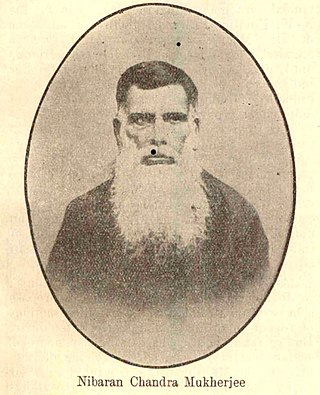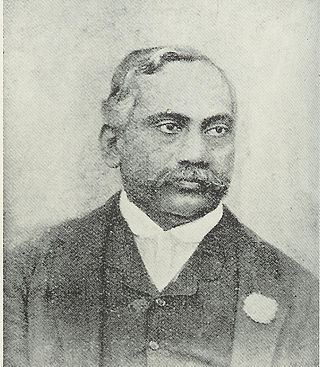Related Research Articles
Contemporary groups, collectively termed Hindu reform movements, reform Hinduism, Neo-Hinduism, or Hindu revivalism, strive to introduce regeneration and reform to Hinduism, both in a religious or spiritual and in a societal sense. The movements started appearing during the Bengali Renaissance.
Brahmo Samaj is the societal component of Brahmoism, which began as a monotheistic reformist movement that appeared during the Bengal Renaissance.
Bengali Brahmos are those who adhere to Brahmoism, the philosophy of Brahmo Samaj which was founded by Raja Rammohan Roy. A recent publication describes the disproportionate influence of Brahmos on India's development post-19th Century as unparalleled in recent times.

Sir Brajendra Nath Seal was a Bengali Indian humanist philosopher. He served as the second vice chancellor of Mysore University.

Keshub Chandra Sen was a Hindu philosopher and social reformer who attempted to incorporate Christian theology within the framework of Hindu thought. Born a Hindu in the Bengal Presidency of British India, he became a member of the Brahmo Samaj in 1857 but established his own breakaway "Bharatvarshiya Brahmo Samaj" in 1866 while the Brahmo Samaj remained under the leadership of Debendranath Tagore. In 1878, his followers abandoned him after the underage child marriage of his daughter which exposed his campaign against child marriage as hollow. Later in his life he came under the influence of Ramakrishna and founded a syncretic "New Dispensation" inspired by Christianity, and Vaishnavbhakti, and Hindu practices.
Girish Chandra Sen was a Bengali religious scholar and translator. He was a Brahmo Samaj missionary and known for being the first publisher of the Qur’an into Bengali language in 1886.

Protap Chunder Mozoomdar was a leader of the Hindu reform movement, the Brahmo Samaj, in Bengal, India, and a close follower of Keshub Chandra Sen. He was a leading exemplar of the interaction between the philosophies and ethics of Hinduism and Christianity, about which he wrote in his book, The Oriental Christ.

Nibaran Chandra Mukherjee was a Brahmo reformer in India during the 19th century.

The Sadharan Brahmo Samaj or Universal Brahmo Samaj is a division of Brahmoism formed as a result of schisms in the Brahmo Samaj first in 1866 and then another in 1878.

Manmohun Ghose was the first practicing barrister of Indian origin. He is notable for his contributions towards the fields of women's education, for arousing the patriotic feeling of his countrymen and for being one of the earliest persons in the country in organised national politics. At the same time his Anglicised habits often made him a target of ridicule in Calcutta.
Brahmoism is a Hindu religious movement which originated from the mid-19th century Bengali Renaissance, the nascent Indian independence movement. Adherents, known as Brahmos, are mainly of Indian or Bangladeshi origin or nationality.
Adi Dharm refers to the religion of Adi Brahmo Samaj the first development of Brahmoism and includes those Sadharan Brahmo Samajists who were reintegrated into Brahmoism after the second schism of 1878 at the instance of Devendranath Tagore. This was the first organised casteless movement in British India and reverberated from its heart of Bengal to Assam, Bombay State, Punjab and Madras, Hyderabad, and Bangalore.

Ananda Mohan Bose was an Indian politician, academician, social reformer, and lawyer during the British Raj. He co-founded the Indian National Association, one of the earliest Indian political organizations, and later became a senior leader of the Indian National Congress. In 1874, he became the first Indian Wrangler of the Cambridge University. He was also a prominent religious leader of Brahmoism and with Sivanath Sastri a leading light of Adi Dharm.
The Indian Reform Association was formed on 29 October 1870 with Keshub Chandra Sen as president. It represented the secular side of the Brahmo Samaj and included many who did not belong to the Brahmo Samaj. The objective was to put into practice some of the ideas Sen was exposed to during his visit to Great Britain.
The Brahmo Conference Organisation (Sammilan) was founded on 27 January 1881 at Mymensingh Bangladesh to maintain communication between Adi Dharm and Sadharan Brahmo Samaj after the 2nd schism of Brahmoism in 1878. The stated objectives for founding the organisation included
The Tattwabodhinī Sabhā was a group founded in Calcutta on 6 October 1839 as a splinter group of the Brahmo Samaj, reformers of Hinduism and Indian Society. The founding member was Debendranath Tagore, previously of the Brahmo Samaj, eldest son of influential entrepreneur Dwarkanath Tagore, and eventually father to renowned polymath Rabindranath Tagore. In 1859, the Tattwabodhinī Sabhā were dissolved back into the Brāhmo Samāj by Debendranath Tagore.

Bijoy Krishna Goswami was a prominent Hindu social reformer and religious figure in India during the British period.

Krishna Kumar Mitra (1852–1936) was an Indian freedom fighter, journalist and leader of the Brahmo Samaj. He is remembered for his contributions to the Swadeshi movement through his journal Sanjibani.
Below is a timeline of Adi Dharm or Adi Brahmo Samaj.

Dwarkanath Gangopadhyay was a Brahmo reformer in Bengal, British India. He made substantial contributions towards societal enlightenment and the emancipation of women. Ganguly dedicated his life to the latter cause, encouraging women to participate in politics and the social services. He was the husband of the first female Indian physician, Kadambini Ganguly.
References
- ↑ Anusthanic Brahmos Archived 2011-07-25 at the Wayback Machine
- 1 2 "The Brahmo Samaj". www.thebrahmosamaj.net. Retrieved 25 October 2023.
- ↑ "The Brahmo Samaj". www.thebrahmosamaj.net. Retrieved 25 October 2023.
- ↑ "Brahmo Samaj, Truths of Brahmoism: Sitanath Tattwabhushan Dutta". Brahmo Samaj, Truths of Brahmoism. 24 May 2009. Retrieved 25 October 2023.
- 1 2 3 4 5 6 Reformist Modernism in The Brahmo Samaj and the shaping of the modern Indian mind. By David Kopf, Princeton, N.J.: Princeton University Press, 1979. page 80-83
- ↑ Kopf, David (1979). The Brahmo Samaj and the Shaping of the Modern Indian Mind. New Delhi: Archives Publishers. p. 358. ISBN 9780691031255.
- ↑ Sengupta, Subodh Chandra and Bose, Anjali (editors), 1976/1998, Sansad Bangali Charitabhidhan (Biographical dictionary) Vol I, (in Bengali), p304, ISBN 81-85626-65-0